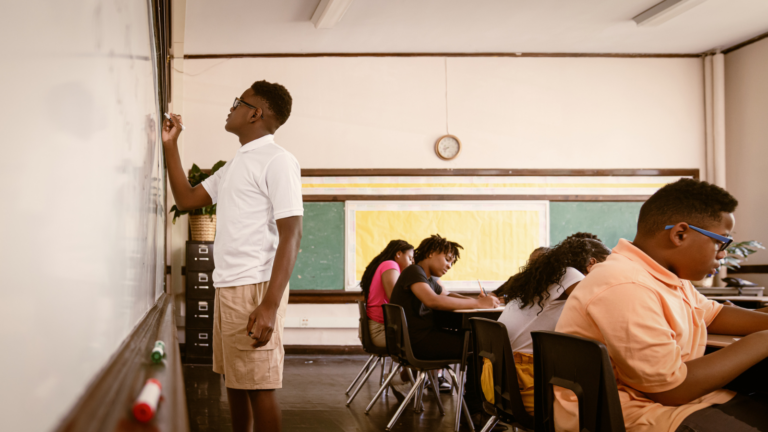Unfortunately, anti-Semitism in schools is not a new issue. Even prior to the onset of the current Israel-Hamas war, anti-Semitic bullying has been on the rise. School districts across the United States, from Cincinnati to Port Washington, New York, had already reported new incidents of anti-Semitism on their campuses within the last few months. Recently, the events in Gaza thrust the Jewish community of faith into the limelight and risk furthering harmful stereotypes. Now more than ever, educators must arm themselves with resources to combat anti-Semitism in the classroom.
Luckily, Jewish educators are committed to providing teachers with the resources to address bias in the classroom. In this piece, we’ll explore tips from top educational organizations and consult with Jewish educators dedicated to combating anti-Semitism in schools. With their knowledge and expertise, you can maintain a safe and inclusive classroom environment for all of your students.
Tip 1: Don’t isolate your conversation around anti-Semitism to big events like the Holocaust.
Miriam Plotinsky, author and instructional specialist with Maryland’s Montgomery County public schools, emphasizes the importance of calling out subtler forms of anti-Semitism in this piece from Education Week. “Antisemitism has a long and complex history dating back thousands of years,” Plotinsky writes. “The problem (with focusing lessons of anti-Semitism on the Holocaust) is learning about what occurred in the late 1930s and early 1940s examines a result, not a cause.” So, what can educators do differently? Plotinsky recommends calling out the ways anti-Semitism manifests in daily life. Harmful tropes and stereotypes about Jewish faith are often left unchecked, and educators need to intervene. This brings us to tip number two …
Tip 2: Be prepared to teach how stereotypes are manifested and why they are harmful.
The issue with allowing stereotypes and tropes to perpetuate unchecked is that younger generations may never question them. Over time, students may even go so far as to accept these representations as being factual. As a result, students who make inappropriate comments may genuinely have no idea what’s wrong with them. Teaching the history behind these misconceptions can become an opportunity for students to learn and develop greater empathy.
Plotinsky illustrates this point beautifully with an example from her own school district. “A few years ago,” she shares, “when I heard students in the hallway talking about ‘stingy Jews’ and stopped to challenge them, the students’ surprise at my vehemence came from not ever pausing to consider why that label might be wrong.”
Just as we wouldn’t let our students leave our classroom thinking capital letters belong in the middle of a word or that a triangle can have multiple right angles, we owe it to them to correct pervasive misconceptions about social groups.
Tip 3: Know that students aren’t the only ones who can express bias.
Unfortunately, a student’s peers are not the only ones who can demonstrate anti-Semitism. As a culturally responsive educator, you may need to be prepared to help your colleagues reflect on ways to be more inclusive of Jewish students and staff members. One of the subtle and unintentional ways bias can manifest is in the pronunciation of names. Correctly pronouncing a student’s name is one of the most basic ways to help them feel comfortable in your classroom.
A 2012 study shared in this article from MIT found that oftentimes “a person’s name may be tied to their identity and carry cultural or family significance. The cumulative experience of having names mispronounced is linked to increased feelings of anxiety, shame, and being ‘othered’ or not belonging in the classroom.”
It is important not to default to an anglicized pronunciation of a student’s name. An example of this could be substituting Ian instead of Idan (ee-dhan). Teachers who notice unfamiliar names on their rosters and want to get ahead of mispronunciation can visit NameShouts. This website is an excellent resource for accurately pronouncing names from all cultures, including common Hebrew names. However, don’t make this your one-stop shop. Be prepared to ask students how they want their names pronounced, and realize that some may request an anglicized pronunciation. The most important thing is that they feel their wishes about what they want to be called are respected.
Educators committed to creating an inclusive environment should also be prepared to intervene if they notice a colleague mispronouncing a student’s chosen name. While this might be an uncomfortable situation, the tips in our piece on addressing Islamophobia in schools can be applied to help you make your case with tactful conviction.
Tip 4: Recognize systems within your school that may be biased against Jewish students.
Addressing stereotypes perpetuated by non-Jewish students is one way to combat bias but is insufficient on its own. Educators also need to actively advocate on behalf of students who are practicing Jews. Even something as simple as the structures in place within a school system may unknowingly be biased against Jewish students. Combating this means having a cultural awareness of the area you teach in. After all, some areas of the United States have significantly larger Jewish populations.
To support theses students, teachers should make themselves aware of any unique needs they may have. This could look like an awareness of when Jewish holidays fall on the calendar. With this awareness, teachers can support students who miss a day of school in getting caught up. It could also look like advocating to include kosher options on your school lunch menu. Schools already work hard to ensure students with allergies or medical dietary restrictions are accommodated. Religious dietary restrictions deserve the same attention.
Tip 5: Be aware that not all Jewish students practice their religion in the same way.
Religious practice and holiday celebrations vary widely between families and households, regardless of the faith being practiced. As an example, some Jewish families may choose not to celebrate nonsecular holidays (think Halloween or Valentine’s Day) due to their roots in religions that do not acknowledge these celebrations. Others readily include these holidays in their family celebrations.
The important thing here is not to make assumptions. When in doubt, check with students and their families to see how your plans will work with their needs. Then, you can adjust accordingly so everyone feels included. Plotinsky shares her own experience with this, saying, “I remember being pleasantly surprised when I transferred to a new school and an administrator came up to me the day before a staff welcome meal to ask if I could eat pizza from the local kosher restaurant.” A little forward thinking on behalf of teachers and administrators can make this level of inclusion the norm rather than a pleasant surprise.
Teachers have the power to combat anti-Semitism in schools.
While the scale of Jewish hate in America and across the globe may bring up feelings of hopelessness, teachers shouldn’t lose hope. With intentional planning, educators can create a school environment where all students are comfortable to learn and grow, without fear of being targeted for their religious beliefs.
For more content like this, be sure to subscribe to our newsletters.


